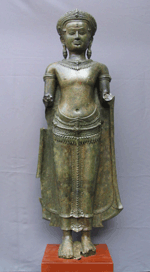There were two branches of Buddhism in practised in ancient Cambodia:
Hinayana the ‘Lesser Vehicle’ and Mahayana the ‘Greater
Vehicle’.
Today, Cambodia practices Theravada Buddhism based on the Pali
text of the Tripitaka (the Three Gems of the Buddha).
According to traditions, there were Five Buddha called the historical
Buddha. Among them, were four who reached Enlightenment. The last
one, was the Buddha Gautama. This fifth Buddha has not yet reached
Enlightenment. His name is Maitreya (Buddha of the Future).
This splendid figure represents a standing adorned Buddha, because
of its specific characteristics described earlier for the Standing Buddha (no. 1).
Since the Angkor period, ancient Khmer artists decorated both
Buddhist and Brahmanist divinities in stone with royal attributes.
The draping of the monastic robes for this Buddha is in the ‘khlum’
style.
As supreme knowledge (Enlightenment) is represented by the luminosity
of the body of the Buddha, monastic robes appear thin and cling
closely to the body so we can clearly see the chest, abdomen,
navel and form of the legs. The panels projecting either side
of the body represent the uttarasanga. The lower part on the ankles
represents the lower edge of the antaravasaka. This under-cloth
passes over the abdomen and is tied with a stylized waistband,
showing a central pleat (between the legs). The waistband is large
and decorated with three rosettes (in front) bordered with pendants.
Each pendant is in a half-petalled lotus form.
The rosettes and the pendants are typical Khmer motifs based
on three fundamental shapes of the lotus flower that symbolize
the purification of life and happiness.
The form of the pectoral collar is very similar to that of Visnu
(no. 2), which proves the continuation of the Khmer ornaments
from the XIth century to XIIth century. The knot of this collar
(at the back) is in the form of a stylized rosette with three
pendants.
The forearms are broken. The Buddha would have been depicted
reaching forward in the ‘dispelling fear’ gesture
(Abhaya mudra). The top of the mitre (mukuta) is broken. The diadem
is large and decorated with very fine patterns. He has long earlobes
with pendants (each pendant is made up of two lotus buds, one
above the other, the upper one in full flower). The armband is
decorated with a rosette.
The toes are of unequal length and the draping of the antaravasaka
(the upper edge rises above the lower back, while leaving the
abdomen exposed) is a characteristic of the Baphuon style (11th
century); this statue can be dated in the end of 11th century
or the beginning of 12th century. The semi-smiling expression
of the face expresses serenity and compassion.


